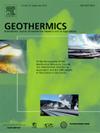Unlocking geothermal potential: Activating calcite-filled veins using chelating agents to improve granitic rock permeability
IF 3.5
2区 工程技术
Q3 ENERGY & FUELS
引用次数: 0
Abstract
Chemical stimulation of geothermal reservoirs using environmentally friendly chelating agents has emerged as a promising method to complement hydraulic stimulation. While hydraulic techniques have been the primary approach for enhancing permeability, numerous basement rock types worldwide contain infilled veins with calcium-bearing minerals (e.g., calcite) that present a significant opportunity for achieving higher permeability improvements through chemical methods. In this study, flooding experiments were performed on fractured granitic rocks with calcite-filled veins at 200 °C using a 20 wt.% N,N-bis(carboxymethyl)-L-glutamic acid (GLDA) solution at a pH of 4. The GLDA solution selectively dissolved calcite, reactivating mineral-filled veins, which provided superior fluid-flow pathways compared to the initial artificial fractures. Reactivated veins resulted in dramatic permeability enhancements, reaching up to three orders of magnitude within two hours of stimulation. These results demonstrate the feasibility and effectiveness of chelating agents-assisted chemical stimulation by activating calcite-filling veins.
释放地热潜力:利用螯合剂激活方解石充填的矿脉,提高花岗岩的渗透性
利用环境友好型螯合剂对地热储层进行化学增产已成为一种很有前途的替代水力增产的方法。虽然水力技术一直是提高渗透率的主要方法,但世界上许多基底岩石类型都含有含钙矿物(如方解石)的充填矿脉,这为通过化学方法提高渗透率提供了一个重要的机会。在这项研究中,采用20 wt.% N,N-二(羧甲基)- l -谷氨酸(GLDA)溶液,在200°C下对裂缝性花岗岩进行了驱油实验。GLDA溶液选择性地溶解方解石,重新激活充满矿物质的矿脉,与最初的人工裂缝相比,提供了更好的流体流动路径。重新激活的静脉渗透性显著增强,在两小时内达到三个数量级。这些结果证明了螯合剂辅助化学刺激激活方解石充填静脉的可行性和有效性。
本文章由计算机程序翻译,如有差异,请以英文原文为准。
求助全文
约1分钟内获得全文
求助全文
来源期刊

Geothermics
工程技术-地球科学综合
CiteScore
7.70
自引率
15.40%
发文量
237
审稿时长
4.5 months
期刊介绍:
Geothermics is an international journal devoted to the research and development of geothermal energy. The International Board of Editors of Geothermics, which comprises specialists in the various aspects of geothermal resources, exploration and development, guarantees the balanced, comprehensive view of scientific and technological developments in this promising energy field.
It promulgates the state of the art and science of geothermal energy, its exploration and exploitation through a regular exchange of information from all parts of the world. The journal publishes articles dealing with the theory, exploration techniques and all aspects of the utilization of geothermal resources. Geothermics serves as the scientific house, or exchange medium, through which the growing community of geothermal specialists can provide and receive information.
 求助内容:
求助内容: 应助结果提醒方式:
应助结果提醒方式:


